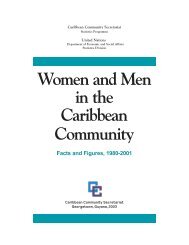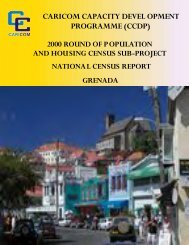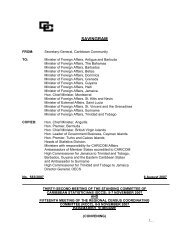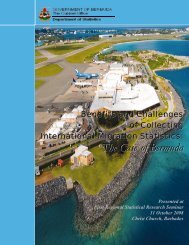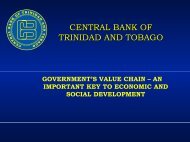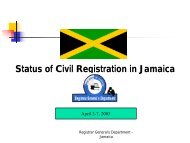- Page 1:
CARICOM CAPACITY DEVELOPMENTPROGRAM
- Page 4:
National Census Report 2001, St. Vi
- Page 7 and 8:
National Census Report 2001, St. Vi
- Page 9 and 10:
National Census Report 2001, St. Vi
- Page 11 and 12:
National Census Report 2001, St. Vi
- Page 13 and 14:
National Census Report 2001, St. Vi
- Page 15 and 16:
National Census Report 2001, St. Vi
- Page 17 and 18:
National Census Report 2001, St. Vi
- Page 19 and 20:
National Census Report 2001, St. Vi
- Page 21 and 22:
National Census Report 2001, St. Vi
- Page 23 and 24:
National Census Report 2001, St. Vi
- Page 25 and 26:
National Census Report 2001, St. Vi
- Page 27 and 28:
National Census Report 2001, St. Vi
- Page 29 and 30:
National Census Report 2001, St. Vi
- Page 31 and 32:
National Census Report 2001, St. Vi
- Page 33 and 34:
National Census Report 2001, St. Vi
- Page 35 and 36:
National Census Report 2001, St. Vi
- Page 37 and 38:
National Census Report 2001, St. Vi
- Page 39 and 40:
National Census Report 2001, St. Vi
- Page 41 and 42:
National Census Report 2001, St. Vi
- Page 43 and 44:
National Census Report 2001, St. Vi
- Page 45 and 46:
National Census Report 2001, St. Vi
- Page 47 and 48:
National Census Report 2001, St. Vi
- Page 49 and 50:
National Census Report 2001, St. Vi
- Page 51 and 52:
National Census Report 2001, St. Vi
- Page 53 and 54:
National Census Report 2001, St. Vi
- Page 55 and 56:
National Census Report 2001, St. Vi
- Page 57 and 58:
National Census Report 2001, St. Vi
- Page 59 and 60:
National Census Report 2001, St. Vi
- Page 61 and 62:
National Census Report 2001, St. Vi
- Page 63 and 64:
National Census Report 2001, St. Vi
- Page 65 and 66:
National Census Report 2001, St. Vi
- Page 67 and 68:
National Census Report 2001, St. Vi
- Page 69 and 70:
National Census Report 2001, St. Vi
- Page 71 and 72:
National Census Report 2001, St. Vi
- Page 73 and 74:
National Census Report 2001, St. Vi
- Page 75 and 76:
National Census Report 2001, St. Vi
- Page 77 and 78:
National Census Report 2001, St. Vi
- Page 79 and 80:
National Census Report 2001, St. Vi
- Page 81 and 82:
National Census Report 2001, St. Vi
- Page 83 and 84:
National Census Report 2001, St. Vi
- Page 85 and 86:
National Census Report 2001, St. Vi
- Page 87 and 88: National Census Report 2001, St. Vi
- Page 89 and 90: National Census Report 2001, St. Vi
- Page 91 and 92: National Census Report 2001, St. Vi
- Page 93 and 94: National Census Report 2001, St. Vi
- Page 95 and 96: National Census Report 2001, St. Vi
- Page 97 and 98: National Census Report 2001, St. Vi
- Page 99 and 100: National Census Report 2001, St. Vi
- Page 101 and 102: National Census Report 2001, St. Vi
- Page 103 and 104: National Census Report 2001, St. Vi
- Page 105 and 106: National Census Report 2001, St. Vi
- Page 107 and 108: National Census Report 2001, St. Vi
- Page 109 and 110: National Census Report 2001, St. Vi
- Page 111 and 112: National Census Report 2001, St. Vi
- Page 113 and 114: National Census Report 2001, St. Vi
- Page 115 and 116: National Census Report 2001, St. Vi
- Page 117 and 118: National Census Report 2001, St. Vi
- Page 119 and 120: National Census Report 2001, St. Vi
- Page 121 and 122: National Census Report 2001, St. Vi
- Page 123 and 124: National Census Report 2001, St. Vi
- Page 125 and 126: National Census Report 2001, St. Vi
- Page 127 and 128: National Census Report 2001, St. Vi
- Page 129 and 130: National Census Report 2001, St. Vi
- Page 131 and 132: National Census Report 2001, St. Vi
- Page 133 and 134: National Census Report 2001, St. Vi
- Page 135 and 136: National Census Report 2001, St. Vi
- Page 137: National Census Report 2001, St. Vi
- Page 141 and 142: National Census Report 2001, St. Vi
- Page 143 and 144: National Census Report 2001, St. Vi
- Page 145 and 146: National Census Report 2001, St. Vi
- Page 147 and 148: National Census Report 2001, St. Vi
- Page 149 and 150: National Census Report 2001, St. Vi
- Page 151 and 152: National Census Report 2001, St. Vi
- Page 153 and 154: National Census Report 2001, St. Vi
- Page 155 and 156: National Census Report 2001, St. Vi
- Page 157 and 158: National Census Report 2001, St. Vi
- Page 159 and 160: National Census Report 2001, St. Vi
- Page 161 and 162: National Census Report 2001, St. Vi
- Page 163 and 164: National Census Report 2001, St. Vi
- Page 165 and 166: National Census Report 2001, St. Vi



